Management and Change in Global Environment Report
VerifiedAdded on 2023/03/20
|14
|4289
|49
Report
AI Summary
This report delves into the critical aspects of change management within organizations operating in a global environment. It begins with an introduction to the concept of change, emphasizing its necessity and the challenges associated with managing it effectively. The report then explores the 'Calm Waters' and 'White Water Rapids' metaphors, providing contrasting perspectives on organizational change. A significant portion is dedicated to John Kotter's eight-step theory of change management, detailing each step from creating urgency to anchoring changes within the corporate culture. The report further examines the role of management in shaping organizational culture during periods of change. To illustrate these concepts, the report analyzes a case study of IBM, focusing on Louis Gerstner's role in transforming the company through strategic change management. The report concludes by summarizing key findings and providing references for further study.

Management and Organization in a global environment
Change management general framework
Change management general framework
Paraphrase This Document
Need a fresh take? Get an instant paraphrase of this document with our AI Paraphraser
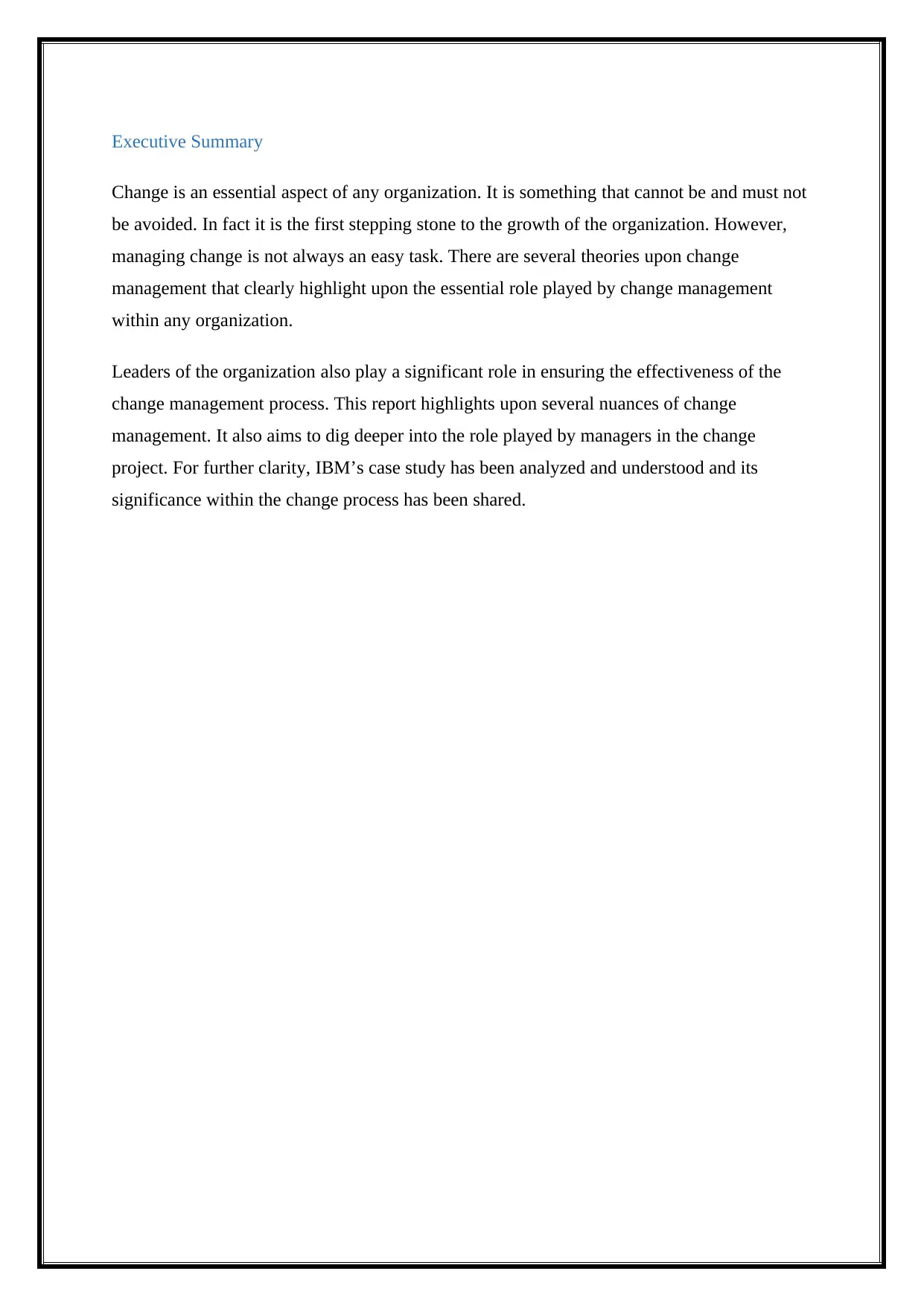
Executive Summary
Change is an essential aspect of any organization. It is something that cannot be and must not
be avoided. In fact it is the first stepping stone to the growth of the organization. However,
managing change is not always an easy task. There are several theories upon change
management that clearly highlight upon the essential role played by change management
within any organization.
Leaders of the organization also play a significant role in ensuring the effectiveness of the
change management process. This report highlights upon several nuances of change
management. It also aims to dig deeper into the role played by managers in the change
project. For further clarity, IBM’s case study has been analyzed and understood and its
significance within the change process has been shared.
Change is an essential aspect of any organization. It is something that cannot be and must not
be avoided. In fact it is the first stepping stone to the growth of the organization. However,
managing change is not always an easy task. There are several theories upon change
management that clearly highlight upon the essential role played by change management
within any organization.
Leaders of the organization also play a significant role in ensuring the effectiveness of the
change management process. This report highlights upon several nuances of change
management. It also aims to dig deeper into the role played by managers in the change
project. For further clarity, IBM’s case study has been analyzed and understood and its
significance within the change process has been shared.
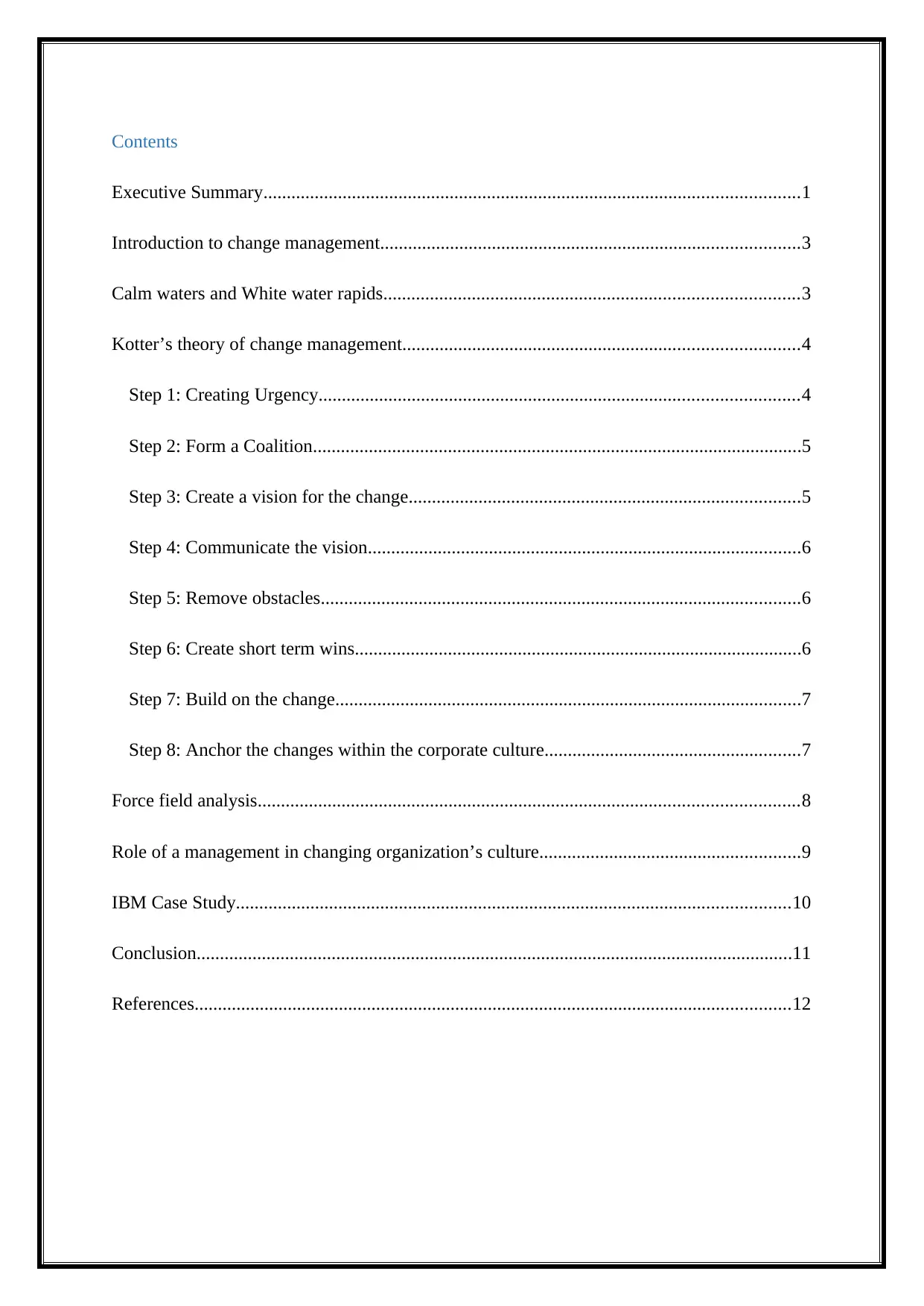
Contents
Executive Summary...................................................................................................................1
Introduction to change management..........................................................................................3
Calm waters and White water rapids.........................................................................................3
Kotter’s theory of change management.....................................................................................4
Step 1: Creating Urgency.......................................................................................................4
Step 2: Form a Coalition.........................................................................................................5
Step 3: Create a vision for the change....................................................................................5
Step 4: Communicate the vision.............................................................................................6
Step 5: Remove obstacles.......................................................................................................6
Step 6: Create short term wins................................................................................................6
Step 7: Build on the change....................................................................................................7
Step 8: Anchor the changes within the corporate culture.......................................................7
Force field analysis....................................................................................................................8
Role of a management in changing organization’s culture........................................................9
IBM Case Study.......................................................................................................................10
Conclusion................................................................................................................................11
References................................................................................................................................12
Executive Summary...................................................................................................................1
Introduction to change management..........................................................................................3
Calm waters and White water rapids.........................................................................................3
Kotter’s theory of change management.....................................................................................4
Step 1: Creating Urgency.......................................................................................................4
Step 2: Form a Coalition.........................................................................................................5
Step 3: Create a vision for the change....................................................................................5
Step 4: Communicate the vision.............................................................................................6
Step 5: Remove obstacles.......................................................................................................6
Step 6: Create short term wins................................................................................................6
Step 7: Build on the change....................................................................................................7
Step 8: Anchor the changes within the corporate culture.......................................................7
Force field analysis....................................................................................................................8
Role of a management in changing organization’s culture........................................................9
IBM Case Study.......................................................................................................................10
Conclusion................................................................................................................................11
References................................................................................................................................12
⊘ This is a preview!⊘
Do you want full access?
Subscribe today to unlock all pages.

Trusted by 1+ million students worldwide
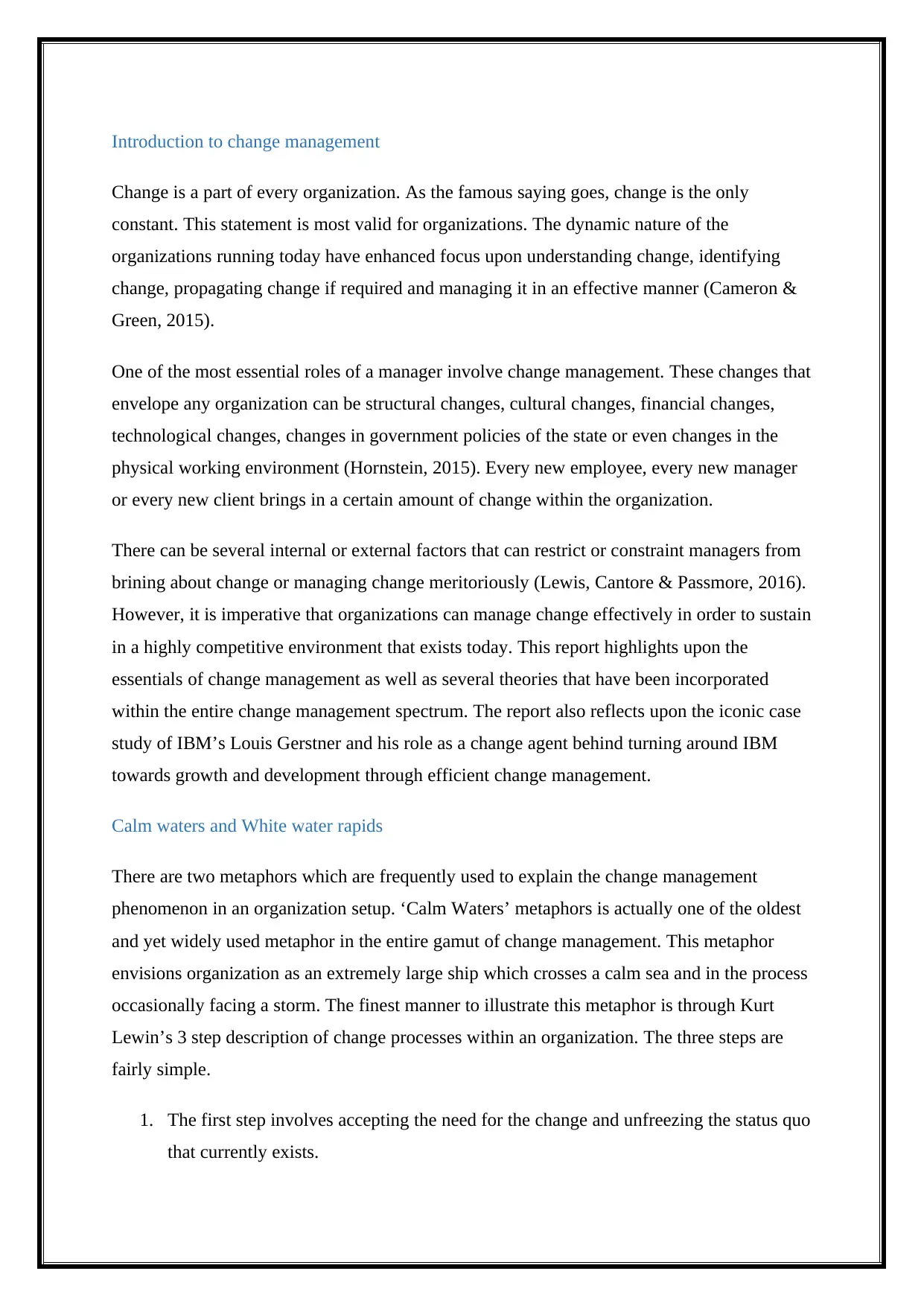
Introduction to change management
Change is a part of every organization. As the famous saying goes, change is the only
constant. This statement is most valid for organizations. The dynamic nature of the
organizations running today have enhanced focus upon understanding change, identifying
change, propagating change if required and managing it in an effective manner (Cameron &
Green, 2015).
One of the most essential roles of a manager involve change management. These changes that
envelope any organization can be structural changes, cultural changes, financial changes,
technological changes, changes in government policies of the state or even changes in the
physical working environment (Hornstein, 2015). Every new employee, every new manager
or every new client brings in a certain amount of change within the organization.
There can be several internal or external factors that can restrict or constraint managers from
brining about change or managing change meritoriously (Lewis, Cantore & Passmore, 2016).
However, it is imperative that organizations can manage change effectively in order to sustain
in a highly competitive environment that exists today. This report highlights upon the
essentials of change management as well as several theories that have been incorporated
within the entire change management spectrum. The report also reflects upon the iconic case
study of IBM’s Louis Gerstner and his role as a change agent behind turning around IBM
towards growth and development through efficient change management.
Calm waters and White water rapids
There are two metaphors which are frequently used to explain the change management
phenomenon in an organization setup. ‘Calm Waters’ metaphors is actually one of the oldest
and yet widely used metaphor in the entire gamut of change management. This metaphor
envisions organization as an extremely large ship which crosses a calm sea and in the process
occasionally facing a storm. The finest manner to illustrate this metaphor is through Kurt
Lewin’s 3 step description of change processes within an organization. The three steps are
fairly simple.
1. The first step involves accepting the need for the change and unfreezing the status quo
that currently exists.
Change is a part of every organization. As the famous saying goes, change is the only
constant. This statement is most valid for organizations. The dynamic nature of the
organizations running today have enhanced focus upon understanding change, identifying
change, propagating change if required and managing it in an effective manner (Cameron &
Green, 2015).
One of the most essential roles of a manager involve change management. These changes that
envelope any organization can be structural changes, cultural changes, financial changes,
technological changes, changes in government policies of the state or even changes in the
physical working environment (Hornstein, 2015). Every new employee, every new manager
or every new client brings in a certain amount of change within the organization.
There can be several internal or external factors that can restrict or constraint managers from
brining about change or managing change meritoriously (Lewis, Cantore & Passmore, 2016).
However, it is imperative that organizations can manage change effectively in order to sustain
in a highly competitive environment that exists today. This report highlights upon the
essentials of change management as well as several theories that have been incorporated
within the entire change management spectrum. The report also reflects upon the iconic case
study of IBM’s Louis Gerstner and his role as a change agent behind turning around IBM
towards growth and development through efficient change management.
Calm waters and White water rapids
There are two metaphors which are frequently used to explain the change management
phenomenon in an organization setup. ‘Calm Waters’ metaphors is actually one of the oldest
and yet widely used metaphor in the entire gamut of change management. This metaphor
envisions organization as an extremely large ship which crosses a calm sea and in the process
occasionally facing a storm. The finest manner to illustrate this metaphor is through Kurt
Lewin’s 3 step description of change processes within an organization. The three steps are
fairly simple.
1. The first step involves accepting the need for the change and unfreezing the status quo
that currently exists.
Paraphrase This Document
Need a fresh take? Get an instant paraphrase of this document with our AI Paraphraser
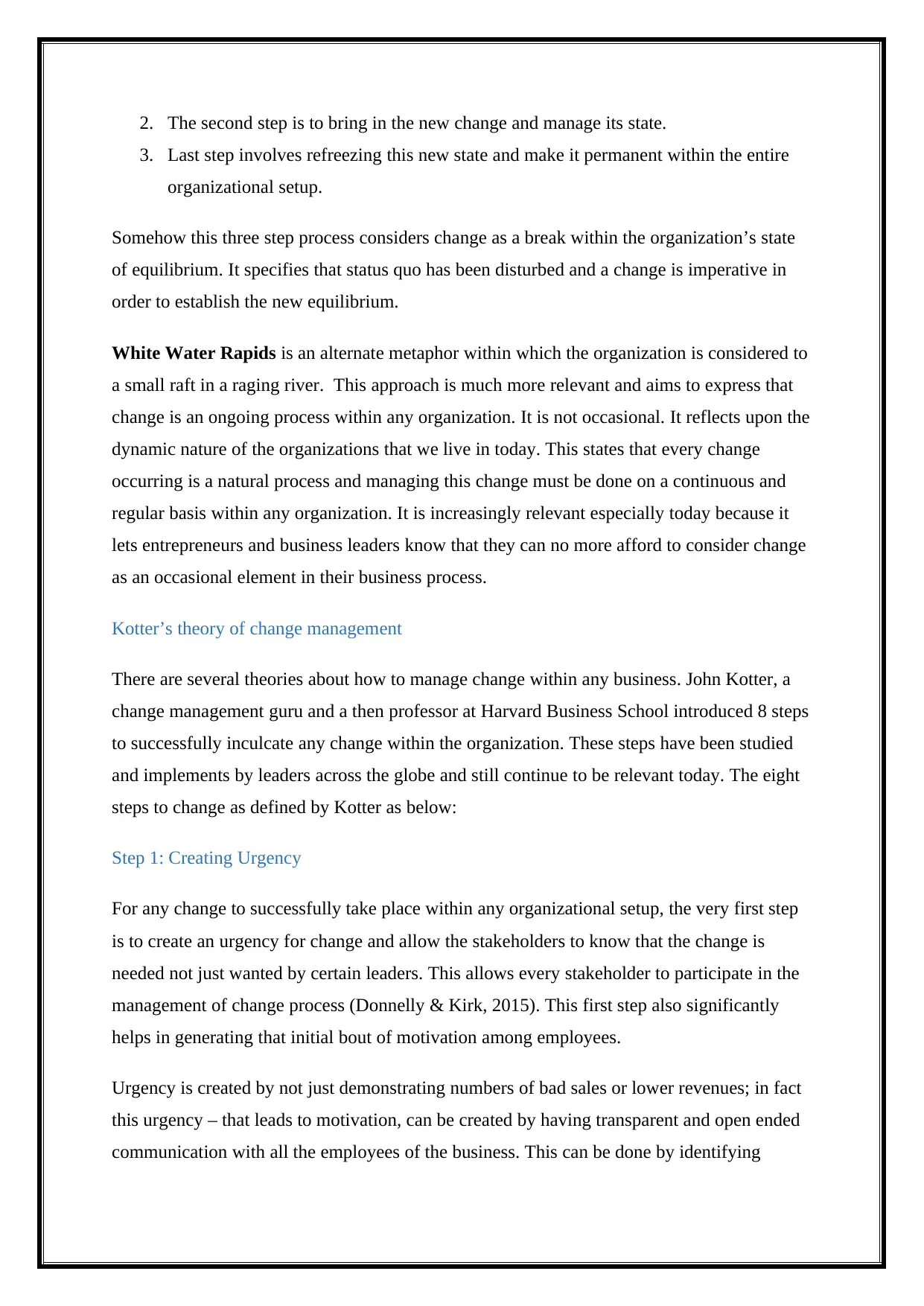
2. The second step is to bring in the new change and manage its state.
3. Last step involves refreezing this new state and make it permanent within the entire
organizational setup.
Somehow this three step process considers change as a break within the organization’s state
of equilibrium. It specifies that status quo has been disturbed and a change is imperative in
order to establish the new equilibrium.
White Water Rapids is an alternate metaphor within which the organization is considered to
a small raft in a raging river. This approach is much more relevant and aims to express that
change is an ongoing process within any organization. It is not occasional. It reflects upon the
dynamic nature of the organizations that we live in today. This states that every change
occurring is a natural process and managing this change must be done on a continuous and
regular basis within any organization. It is increasingly relevant especially today because it
lets entrepreneurs and business leaders know that they can no more afford to consider change
as an occasional element in their business process.
Kotter’s theory of change management
There are several theories about how to manage change within any business. John Kotter, a
change management guru and a then professor at Harvard Business School introduced 8 steps
to successfully inculcate any change within the organization. These steps have been studied
and implements by leaders across the globe and still continue to be relevant today. The eight
steps to change as defined by Kotter as below:
Step 1: Creating Urgency
For any change to successfully take place within any organizational setup, the very first step
is to create an urgency for change and allow the stakeholders to know that the change is
needed not just wanted by certain leaders. This allows every stakeholder to participate in the
management of change process (Donnelly & Kirk, 2015). This first step also significantly
helps in generating that initial bout of motivation among employees.
Urgency is created by not just demonstrating numbers of bad sales or lower revenues; in fact
this urgency – that leads to motivation, can be created by having transparent and open ended
communication with all the employees of the business. This can be done by identifying
3. Last step involves refreezing this new state and make it permanent within the entire
organizational setup.
Somehow this three step process considers change as a break within the organization’s state
of equilibrium. It specifies that status quo has been disturbed and a change is imperative in
order to establish the new equilibrium.
White Water Rapids is an alternate metaphor within which the organization is considered to
a small raft in a raging river. This approach is much more relevant and aims to express that
change is an ongoing process within any organization. It is not occasional. It reflects upon the
dynamic nature of the organizations that we live in today. This states that every change
occurring is a natural process and managing this change must be done on a continuous and
regular basis within any organization. It is increasingly relevant especially today because it
lets entrepreneurs and business leaders know that they can no more afford to consider change
as an occasional element in their business process.
Kotter’s theory of change management
There are several theories about how to manage change within any business. John Kotter, a
change management guru and a then professor at Harvard Business School introduced 8 steps
to successfully inculcate any change within the organization. These steps have been studied
and implements by leaders across the globe and still continue to be relevant today. The eight
steps to change as defined by Kotter as below:
Step 1: Creating Urgency
For any change to successfully take place within any organizational setup, the very first step
is to create an urgency for change and allow the stakeholders to know that the change is
needed not just wanted by certain leaders. This allows every stakeholder to participate in the
management of change process (Donnelly & Kirk, 2015). This first step also significantly
helps in generating that initial bout of motivation among employees.
Urgency is created by not just demonstrating numbers of bad sales or lower revenues; in fact
this urgency – that leads to motivation, can be created by having transparent and open ended
communication with all the employees of the business. This can be done by identifying
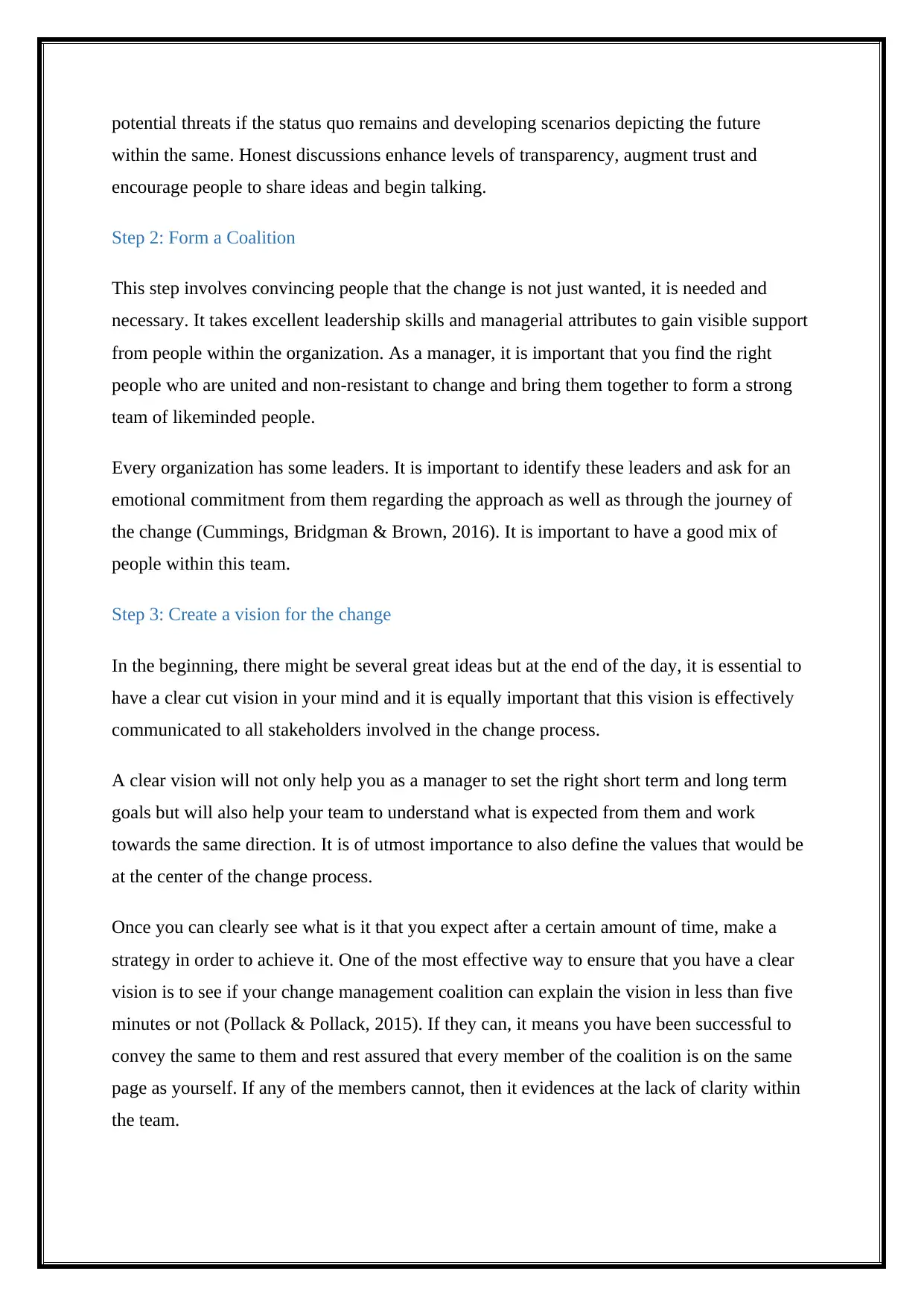
potential threats if the status quo remains and developing scenarios depicting the future
within the same. Honest discussions enhance levels of transparency, augment trust and
encourage people to share ideas and begin talking.
Step 2: Form a Coalition
This step involves convincing people that the change is not just wanted, it is needed and
necessary. It takes excellent leadership skills and managerial attributes to gain visible support
from people within the organization. As a manager, it is important that you find the right
people who are united and non-resistant to change and bring them together to form a strong
team of likeminded people.
Every organization has some leaders. It is important to identify these leaders and ask for an
emotional commitment from them regarding the approach as well as through the journey of
the change (Cummings, Bridgman & Brown, 2016). It is important to have a good mix of
people within this team.
Step 3: Create a vision for the change
In the beginning, there might be several great ideas but at the end of the day, it is essential to
have a clear cut vision in your mind and it is equally important that this vision is effectively
communicated to all stakeholders involved in the change process.
A clear vision will not only help you as a manager to set the right short term and long term
goals but will also help your team to understand what is expected from them and work
towards the same direction. It is of utmost importance to also define the values that would be
at the center of the change process.
Once you can clearly see what is it that you expect after a certain amount of time, make a
strategy in order to achieve it. One of the most effective way to ensure that you have a clear
vision is to see if your change management coalition can explain the vision in less than five
minutes or not (Pollack & Pollack, 2015). If they can, it means you have been successful to
convey the same to them and rest assured that every member of the coalition is on the same
page as yourself. If any of the members cannot, then it evidences at the lack of clarity within
the team.
within the same. Honest discussions enhance levels of transparency, augment trust and
encourage people to share ideas and begin talking.
Step 2: Form a Coalition
This step involves convincing people that the change is not just wanted, it is needed and
necessary. It takes excellent leadership skills and managerial attributes to gain visible support
from people within the organization. As a manager, it is important that you find the right
people who are united and non-resistant to change and bring them together to form a strong
team of likeminded people.
Every organization has some leaders. It is important to identify these leaders and ask for an
emotional commitment from them regarding the approach as well as through the journey of
the change (Cummings, Bridgman & Brown, 2016). It is important to have a good mix of
people within this team.
Step 3: Create a vision for the change
In the beginning, there might be several great ideas but at the end of the day, it is essential to
have a clear cut vision in your mind and it is equally important that this vision is effectively
communicated to all stakeholders involved in the change process.
A clear vision will not only help you as a manager to set the right short term and long term
goals but will also help your team to understand what is expected from them and work
towards the same direction. It is of utmost importance to also define the values that would be
at the center of the change process.
Once you can clearly see what is it that you expect after a certain amount of time, make a
strategy in order to achieve it. One of the most effective way to ensure that you have a clear
vision is to see if your change management coalition can explain the vision in less than five
minutes or not (Pollack & Pollack, 2015). If they can, it means you have been successful to
convey the same to them and rest assured that every member of the coalition is on the same
page as yourself. If any of the members cannot, then it evidences at the lack of clarity within
the team.
⊘ This is a preview!⊘
Do you want full access?
Subscribe today to unlock all pages.

Trusted by 1+ million students worldwide
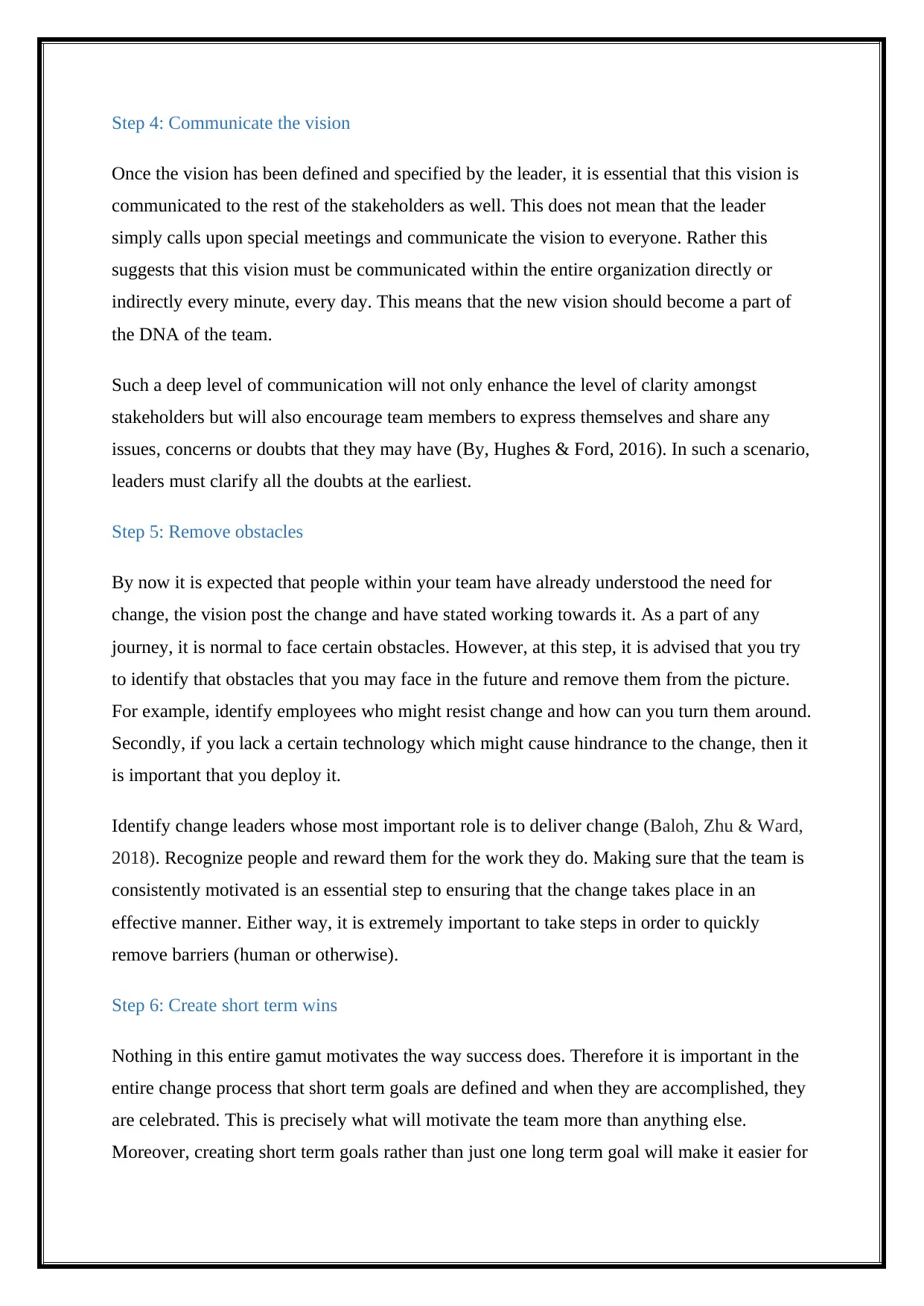
Step 4: Communicate the vision
Once the vision has been defined and specified by the leader, it is essential that this vision is
communicated to the rest of the stakeholders as well. This does not mean that the leader
simply calls upon special meetings and communicate the vision to everyone. Rather this
suggests that this vision must be communicated within the entire organization directly or
indirectly every minute, every day. This means that the new vision should become a part of
the DNA of the team.
Such a deep level of communication will not only enhance the level of clarity amongst
stakeholders but will also encourage team members to express themselves and share any
issues, concerns or doubts that they may have (By, Hughes & Ford, 2016). In such a scenario,
leaders must clarify all the doubts at the earliest.
Step 5: Remove obstacles
By now it is expected that people within your team have already understood the need for
change, the vision post the change and have stated working towards it. As a part of any
journey, it is normal to face certain obstacles. However, at this step, it is advised that you try
to identify that obstacles that you may face in the future and remove them from the picture.
For example, identify employees who might resist change and how can you turn them around.
Secondly, if you lack a certain technology which might cause hindrance to the change, then it
is important that you deploy it.
Identify change leaders whose most important role is to deliver change (Baloh, Zhu & Ward,
2018). Recognize people and reward them for the work they do. Making sure that the team is
consistently motivated is an essential step to ensuring that the change takes place in an
effective manner. Either way, it is extremely important to take steps in order to quickly
remove barriers (human or otherwise).
Step 6: Create short term wins
Nothing in this entire gamut motivates the way success does. Therefore it is important in the
entire change process that short term goals are defined and when they are accomplished, they
are celebrated. This is precisely what will motivate the team more than anything else.
Moreover, creating short term goals rather than just one long term goal will make it easier for
Once the vision has been defined and specified by the leader, it is essential that this vision is
communicated to the rest of the stakeholders as well. This does not mean that the leader
simply calls upon special meetings and communicate the vision to everyone. Rather this
suggests that this vision must be communicated within the entire organization directly or
indirectly every minute, every day. This means that the new vision should become a part of
the DNA of the team.
Such a deep level of communication will not only enhance the level of clarity amongst
stakeholders but will also encourage team members to express themselves and share any
issues, concerns or doubts that they may have (By, Hughes & Ford, 2016). In such a scenario,
leaders must clarify all the doubts at the earliest.
Step 5: Remove obstacles
By now it is expected that people within your team have already understood the need for
change, the vision post the change and have stated working towards it. As a part of any
journey, it is normal to face certain obstacles. However, at this step, it is advised that you try
to identify that obstacles that you may face in the future and remove them from the picture.
For example, identify employees who might resist change and how can you turn them around.
Secondly, if you lack a certain technology which might cause hindrance to the change, then it
is important that you deploy it.
Identify change leaders whose most important role is to deliver change (Baloh, Zhu & Ward,
2018). Recognize people and reward them for the work they do. Making sure that the team is
consistently motivated is an essential step to ensuring that the change takes place in an
effective manner. Either way, it is extremely important to take steps in order to quickly
remove barriers (human or otherwise).
Step 6: Create short term wins
Nothing in this entire gamut motivates the way success does. Therefore it is important in the
entire change process that short term goals are defined and when they are accomplished, they
are celebrated. This is precisely what will motivate the team more than anything else.
Moreover, creating short term goals rather than just one long term goal will make it easier for
Paraphrase This Document
Need a fresh take? Get an instant paraphrase of this document with our AI Paraphraser
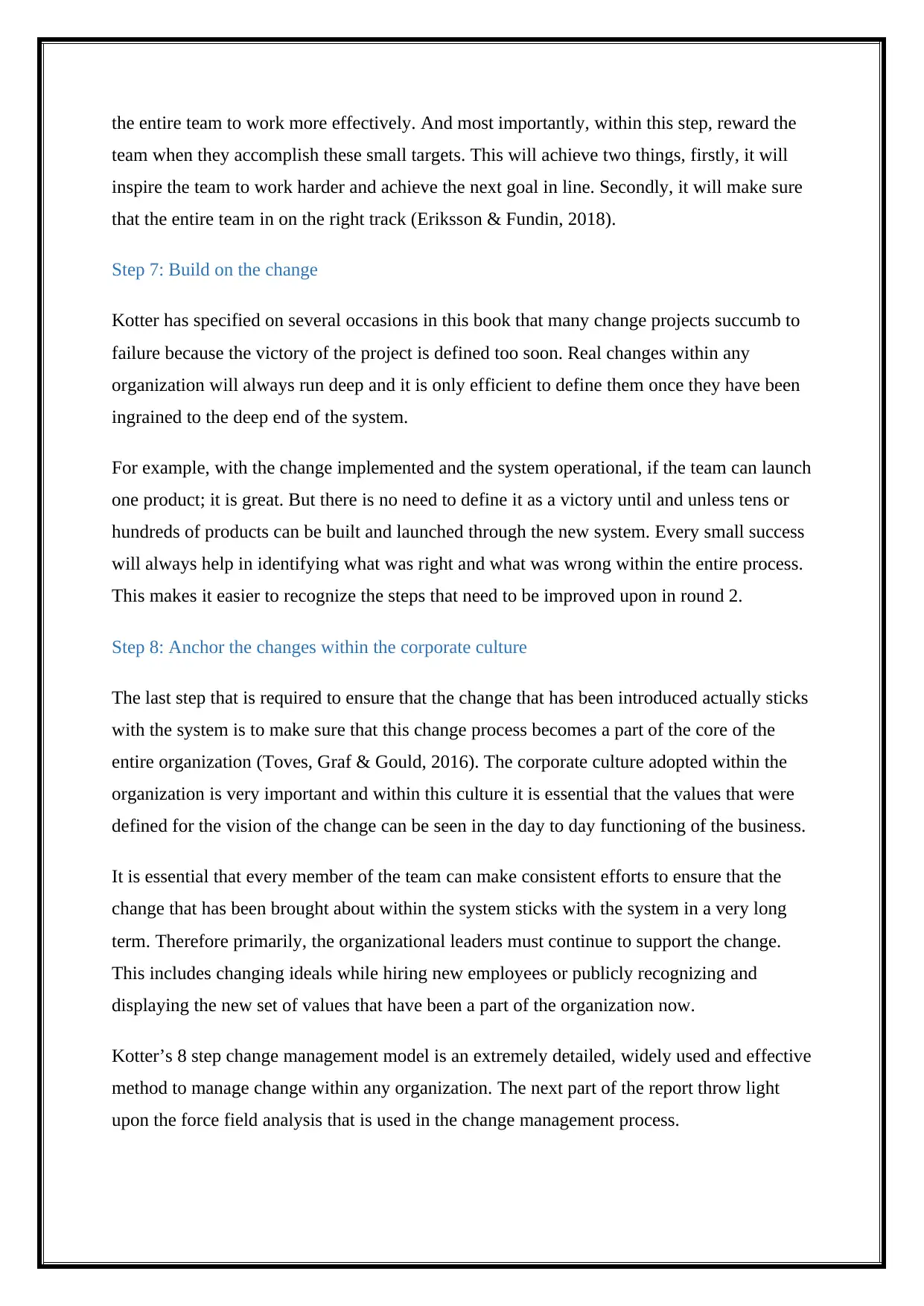
the entire team to work more effectively. And most importantly, within this step, reward the
team when they accomplish these small targets. This will achieve two things, firstly, it will
inspire the team to work harder and achieve the next goal in line. Secondly, it will make sure
that the entire team in on the right track (Eriksson & Fundin, 2018).
Step 7: Build on the change
Kotter has specified on several occasions in this book that many change projects succumb to
failure because the victory of the project is defined too soon. Real changes within any
organization will always run deep and it is only efficient to define them once they have been
ingrained to the deep end of the system.
For example, with the change implemented and the system operational, if the team can launch
one product; it is great. But there is no need to define it as a victory until and unless tens or
hundreds of products can be built and launched through the new system. Every small success
will always help in identifying what was right and what was wrong within the entire process.
This makes it easier to recognize the steps that need to be improved upon in round 2.
Step 8: Anchor the changes within the corporate culture
The last step that is required to ensure that the change that has been introduced actually sticks
with the system is to make sure that this change process becomes a part of the core of the
entire organization (Toves, Graf & Gould, 2016). The corporate culture adopted within the
organization is very important and within this culture it is essential that the values that were
defined for the vision of the change can be seen in the day to day functioning of the business.
It is essential that every member of the team can make consistent efforts to ensure that the
change that has been brought about within the system sticks with the system in a very long
term. Therefore primarily, the organizational leaders must continue to support the change.
This includes changing ideals while hiring new employees or publicly recognizing and
displaying the new set of values that have been a part of the organization now.
Kotter’s 8 step change management model is an extremely detailed, widely used and effective
method to manage change within any organization. The next part of the report throw light
upon the force field analysis that is used in the change management process.
team when they accomplish these small targets. This will achieve two things, firstly, it will
inspire the team to work harder and achieve the next goal in line. Secondly, it will make sure
that the entire team in on the right track (Eriksson & Fundin, 2018).
Step 7: Build on the change
Kotter has specified on several occasions in this book that many change projects succumb to
failure because the victory of the project is defined too soon. Real changes within any
organization will always run deep and it is only efficient to define them once they have been
ingrained to the deep end of the system.
For example, with the change implemented and the system operational, if the team can launch
one product; it is great. But there is no need to define it as a victory until and unless tens or
hundreds of products can be built and launched through the new system. Every small success
will always help in identifying what was right and what was wrong within the entire process.
This makes it easier to recognize the steps that need to be improved upon in round 2.
Step 8: Anchor the changes within the corporate culture
The last step that is required to ensure that the change that has been introduced actually sticks
with the system is to make sure that this change process becomes a part of the core of the
entire organization (Toves, Graf & Gould, 2016). The corporate culture adopted within the
organization is very important and within this culture it is essential that the values that were
defined for the vision of the change can be seen in the day to day functioning of the business.
It is essential that every member of the team can make consistent efforts to ensure that the
change that has been brought about within the system sticks with the system in a very long
term. Therefore primarily, the organizational leaders must continue to support the change.
This includes changing ideals while hiring new employees or publicly recognizing and
displaying the new set of values that have been a part of the organization now.
Kotter’s 8 step change management model is an extremely detailed, widely used and effective
method to manage change within any organization. The next part of the report throw light
upon the force field analysis that is used in the change management process.
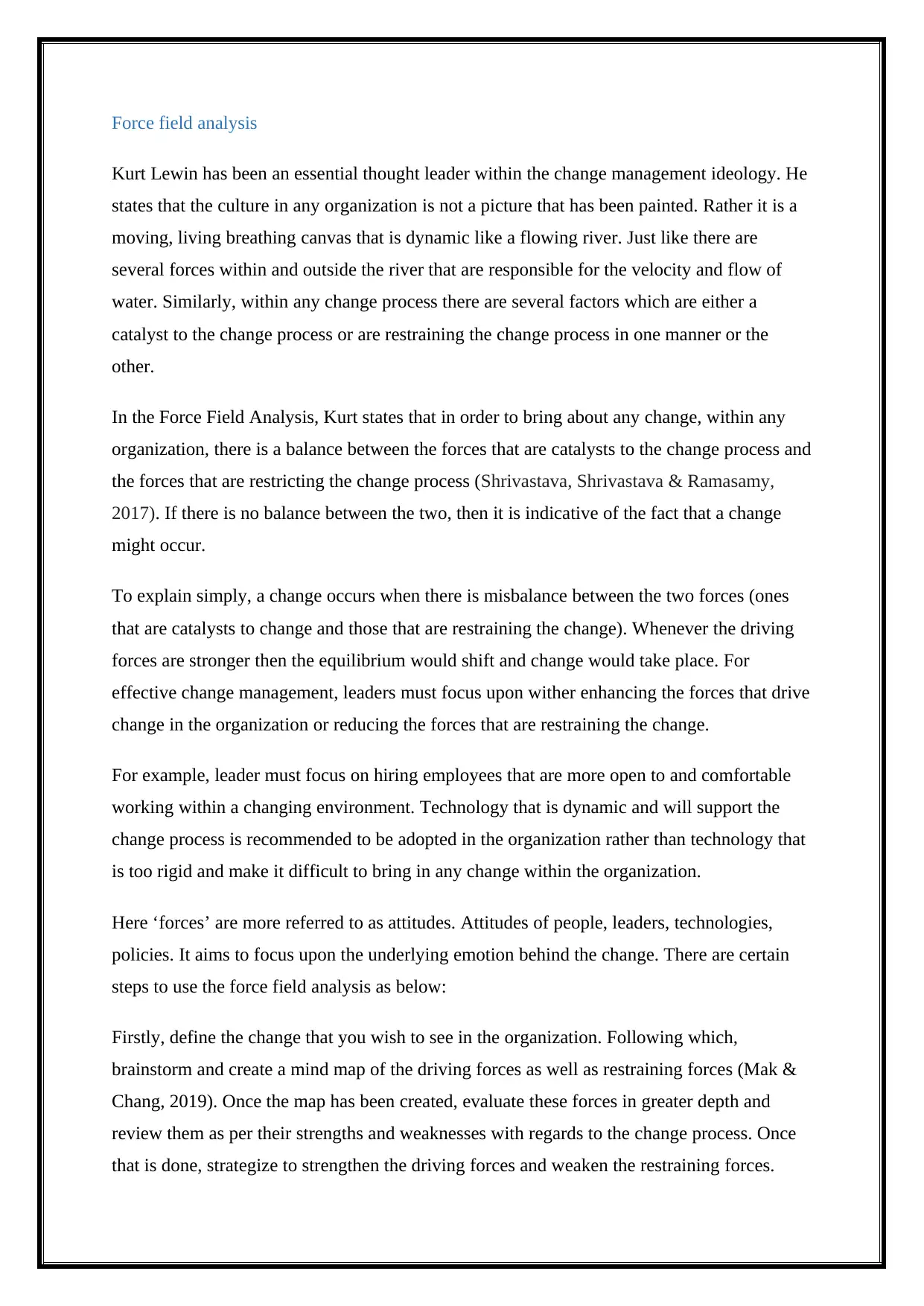
Force field analysis
Kurt Lewin has been an essential thought leader within the change management ideology. He
states that the culture in any organization is not a picture that has been painted. Rather it is a
moving, living breathing canvas that is dynamic like a flowing river. Just like there are
several forces within and outside the river that are responsible for the velocity and flow of
water. Similarly, within any change process there are several factors which are either a
catalyst to the change process or are restraining the change process in one manner or the
other.
In the Force Field Analysis, Kurt states that in order to bring about any change, within any
organization, there is a balance between the forces that are catalysts to the change process and
the forces that are restricting the change process (Shrivastava, Shrivastava & Ramasamy,
2017). If there is no balance between the two, then it is indicative of the fact that a change
might occur.
To explain simply, a change occurs when there is misbalance between the two forces (ones
that are catalysts to change and those that are restraining the change). Whenever the driving
forces are stronger then the equilibrium would shift and change would take place. For
effective change management, leaders must focus upon wither enhancing the forces that drive
change in the organization or reducing the forces that are restraining the change.
For example, leader must focus on hiring employees that are more open to and comfortable
working within a changing environment. Technology that is dynamic and will support the
change process is recommended to be adopted in the organization rather than technology that
is too rigid and make it difficult to bring in any change within the organization.
Here ‘forces’ are more referred to as attitudes. Attitudes of people, leaders, technologies,
policies. It aims to focus upon the underlying emotion behind the change. There are certain
steps to use the force field analysis as below:
Firstly, define the change that you wish to see in the organization. Following which,
brainstorm and create a mind map of the driving forces as well as restraining forces (Mak &
Chang, 2019). Once the map has been created, evaluate these forces in greater depth and
review them as per their strengths and weaknesses with regards to the change process. Once
that is done, strategize to strengthen the driving forces and weaken the restraining forces.
Kurt Lewin has been an essential thought leader within the change management ideology. He
states that the culture in any organization is not a picture that has been painted. Rather it is a
moving, living breathing canvas that is dynamic like a flowing river. Just like there are
several forces within and outside the river that are responsible for the velocity and flow of
water. Similarly, within any change process there are several factors which are either a
catalyst to the change process or are restraining the change process in one manner or the
other.
In the Force Field Analysis, Kurt states that in order to bring about any change, within any
organization, there is a balance between the forces that are catalysts to the change process and
the forces that are restricting the change process (Shrivastava, Shrivastava & Ramasamy,
2017). If there is no balance between the two, then it is indicative of the fact that a change
might occur.
To explain simply, a change occurs when there is misbalance between the two forces (ones
that are catalysts to change and those that are restraining the change). Whenever the driving
forces are stronger then the equilibrium would shift and change would take place. For
effective change management, leaders must focus upon wither enhancing the forces that drive
change in the organization or reducing the forces that are restraining the change.
For example, leader must focus on hiring employees that are more open to and comfortable
working within a changing environment. Technology that is dynamic and will support the
change process is recommended to be adopted in the organization rather than technology that
is too rigid and make it difficult to bring in any change within the organization.
Here ‘forces’ are more referred to as attitudes. Attitudes of people, leaders, technologies,
policies. It aims to focus upon the underlying emotion behind the change. There are certain
steps to use the force field analysis as below:
Firstly, define the change that you wish to see in the organization. Following which,
brainstorm and create a mind map of the driving forces as well as restraining forces (Mak &
Chang, 2019). Once the map has been created, evaluate these forces in greater depth and
review them as per their strengths and weaknesses with regards to the change process. Once
that is done, strategize to strengthen the driving forces and weaken the restraining forces.
⊘ This is a preview!⊘
Do you want full access?
Subscribe today to unlock all pages.

Trusted by 1+ million students worldwide
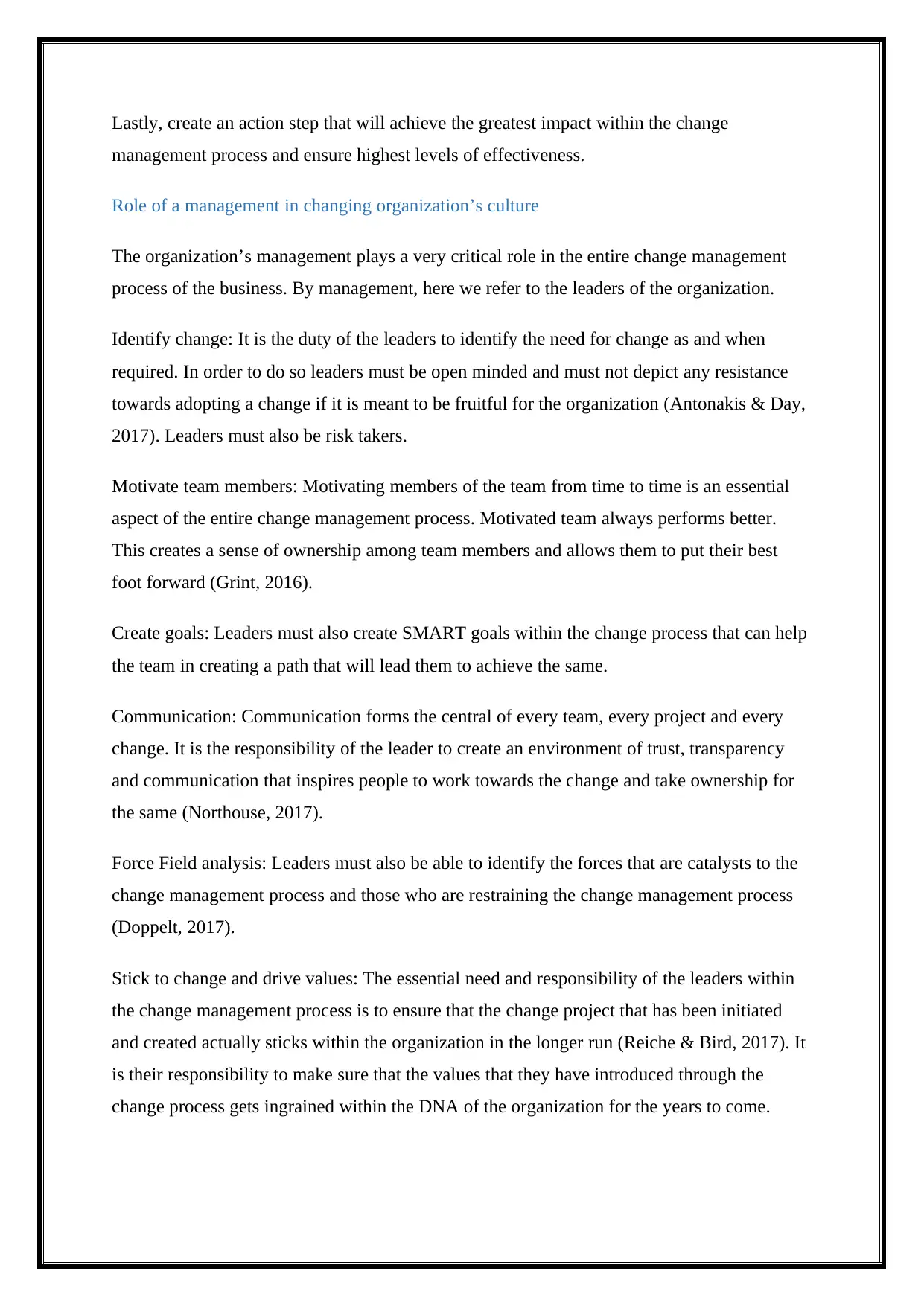
Lastly, create an action step that will achieve the greatest impact within the change
management process and ensure highest levels of effectiveness.
Role of a management in changing organization’s culture
The organization’s management plays a very critical role in the entire change management
process of the business. By management, here we refer to the leaders of the organization.
Identify change: It is the duty of the leaders to identify the need for change as and when
required. In order to do so leaders must be open minded and must not depict any resistance
towards adopting a change if it is meant to be fruitful for the organization (Antonakis & Day,
2017). Leaders must also be risk takers.
Motivate team members: Motivating members of the team from time to time is an essential
aspect of the entire change management process. Motivated team always performs better.
This creates a sense of ownership among team members and allows them to put their best
foot forward (Grint, 2016).
Create goals: Leaders must also create SMART goals within the change process that can help
the team in creating a path that will lead them to achieve the same.
Communication: Communication forms the central of every team, every project and every
change. It is the responsibility of the leader to create an environment of trust, transparency
and communication that inspires people to work towards the change and take ownership for
the same (Northouse, 2017).
Force Field analysis: Leaders must also be able to identify the forces that are catalysts to the
change management process and those who are restraining the change management process
(Doppelt, 2017).
Stick to change and drive values: The essential need and responsibility of the leaders within
the change management process is to ensure that the change project that has been initiated
and created actually sticks within the organization in the longer run (Reiche & Bird, 2017). It
is their responsibility to make sure that the values that they have introduced through the
change process gets ingrained within the DNA of the organization for the years to come.
management process and ensure highest levels of effectiveness.
Role of a management in changing organization’s culture
The organization’s management plays a very critical role in the entire change management
process of the business. By management, here we refer to the leaders of the organization.
Identify change: It is the duty of the leaders to identify the need for change as and when
required. In order to do so leaders must be open minded and must not depict any resistance
towards adopting a change if it is meant to be fruitful for the organization (Antonakis & Day,
2017). Leaders must also be risk takers.
Motivate team members: Motivating members of the team from time to time is an essential
aspect of the entire change management process. Motivated team always performs better.
This creates a sense of ownership among team members and allows them to put their best
foot forward (Grint, 2016).
Create goals: Leaders must also create SMART goals within the change process that can help
the team in creating a path that will lead them to achieve the same.
Communication: Communication forms the central of every team, every project and every
change. It is the responsibility of the leader to create an environment of trust, transparency
and communication that inspires people to work towards the change and take ownership for
the same (Northouse, 2017).
Force Field analysis: Leaders must also be able to identify the forces that are catalysts to the
change management process and those who are restraining the change management process
(Doppelt, 2017).
Stick to change and drive values: The essential need and responsibility of the leaders within
the change management process is to ensure that the change project that has been initiated
and created actually sticks within the organization in the longer run (Reiche & Bird, 2017). It
is their responsibility to make sure that the values that they have introduced through the
change process gets ingrained within the DNA of the organization for the years to come.
Paraphrase This Document
Need a fresh take? Get an instant paraphrase of this document with our AI Paraphraser
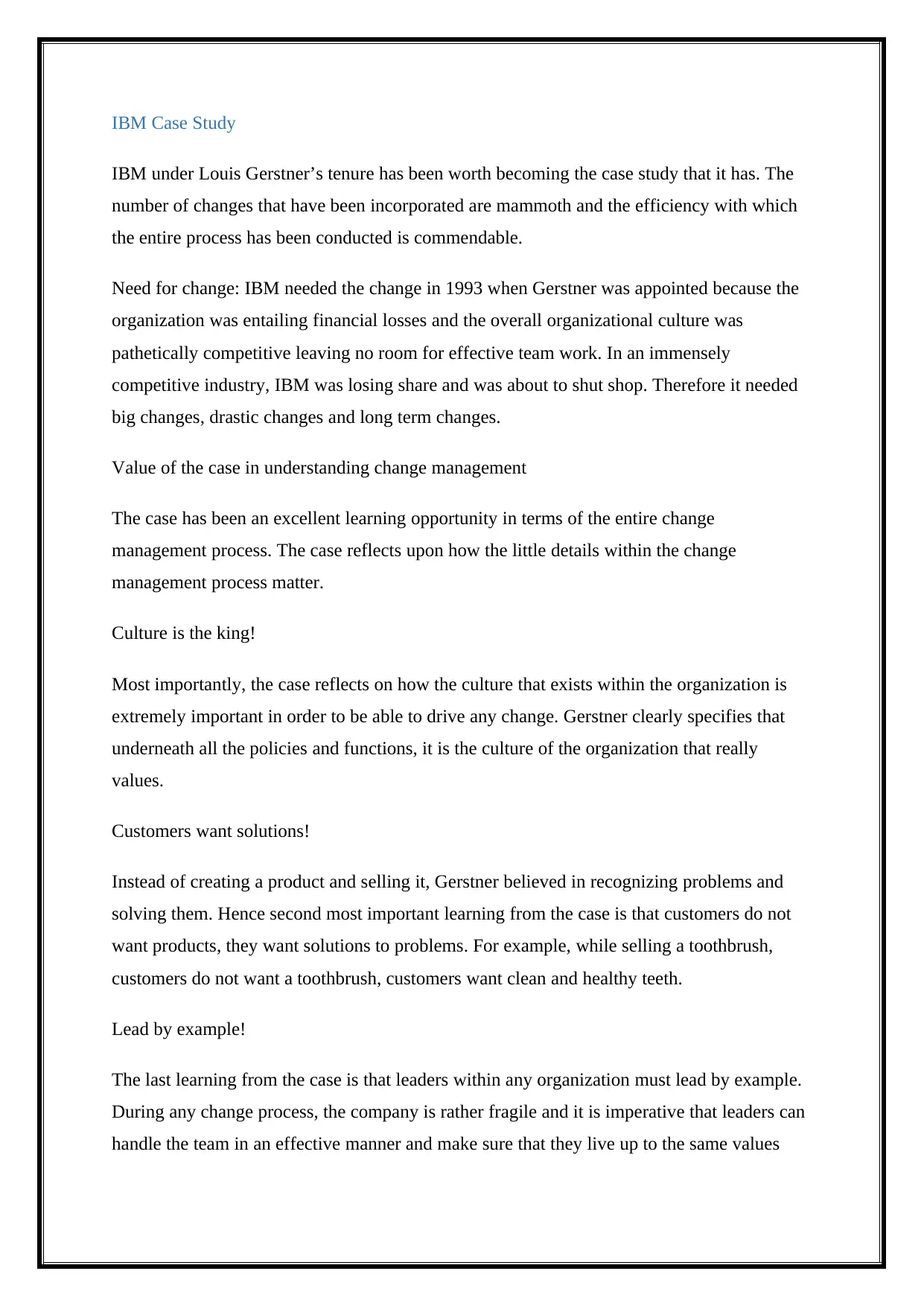
IBM Case Study
IBM under Louis Gerstner’s tenure has been worth becoming the case study that it has. The
number of changes that have been incorporated are mammoth and the efficiency with which
the entire process has been conducted is commendable.
Need for change: IBM needed the change in 1993 when Gerstner was appointed because the
organization was entailing financial losses and the overall organizational culture was
pathetically competitive leaving no room for effective team work. In an immensely
competitive industry, IBM was losing share and was about to shut shop. Therefore it needed
big changes, drastic changes and long term changes.
Value of the case in understanding change management
The case has been an excellent learning opportunity in terms of the entire change
management process. The case reflects upon how the little details within the change
management process matter.
Culture is the king!
Most importantly, the case reflects on how the culture that exists within the organization is
extremely important in order to be able to drive any change. Gerstner clearly specifies that
underneath all the policies and functions, it is the culture of the organization that really
values.
Customers want solutions!
Instead of creating a product and selling it, Gerstner believed in recognizing problems and
solving them. Hence second most important learning from the case is that customers do not
want products, they want solutions to problems. For example, while selling a toothbrush,
customers do not want a toothbrush, customers want clean and healthy teeth.
Lead by example!
The last learning from the case is that leaders within any organization must lead by example.
During any change process, the company is rather fragile and it is imperative that leaders can
handle the team in an effective manner and make sure that they live up to the same values
IBM under Louis Gerstner’s tenure has been worth becoming the case study that it has. The
number of changes that have been incorporated are mammoth and the efficiency with which
the entire process has been conducted is commendable.
Need for change: IBM needed the change in 1993 when Gerstner was appointed because the
organization was entailing financial losses and the overall organizational culture was
pathetically competitive leaving no room for effective team work. In an immensely
competitive industry, IBM was losing share and was about to shut shop. Therefore it needed
big changes, drastic changes and long term changes.
Value of the case in understanding change management
The case has been an excellent learning opportunity in terms of the entire change
management process. The case reflects upon how the little details within the change
management process matter.
Culture is the king!
Most importantly, the case reflects on how the culture that exists within the organization is
extremely important in order to be able to drive any change. Gerstner clearly specifies that
underneath all the policies and functions, it is the culture of the organization that really
values.
Customers want solutions!
Instead of creating a product and selling it, Gerstner believed in recognizing problems and
solving them. Hence second most important learning from the case is that customers do not
want products, they want solutions to problems. For example, while selling a toothbrush,
customers do not want a toothbrush, customers want clean and healthy teeth.
Lead by example!
The last learning from the case is that leaders within any organization must lead by example.
During any change process, the company is rather fragile and it is imperative that leaders can
handle the team in an effective manner and make sure that they live up to the same values
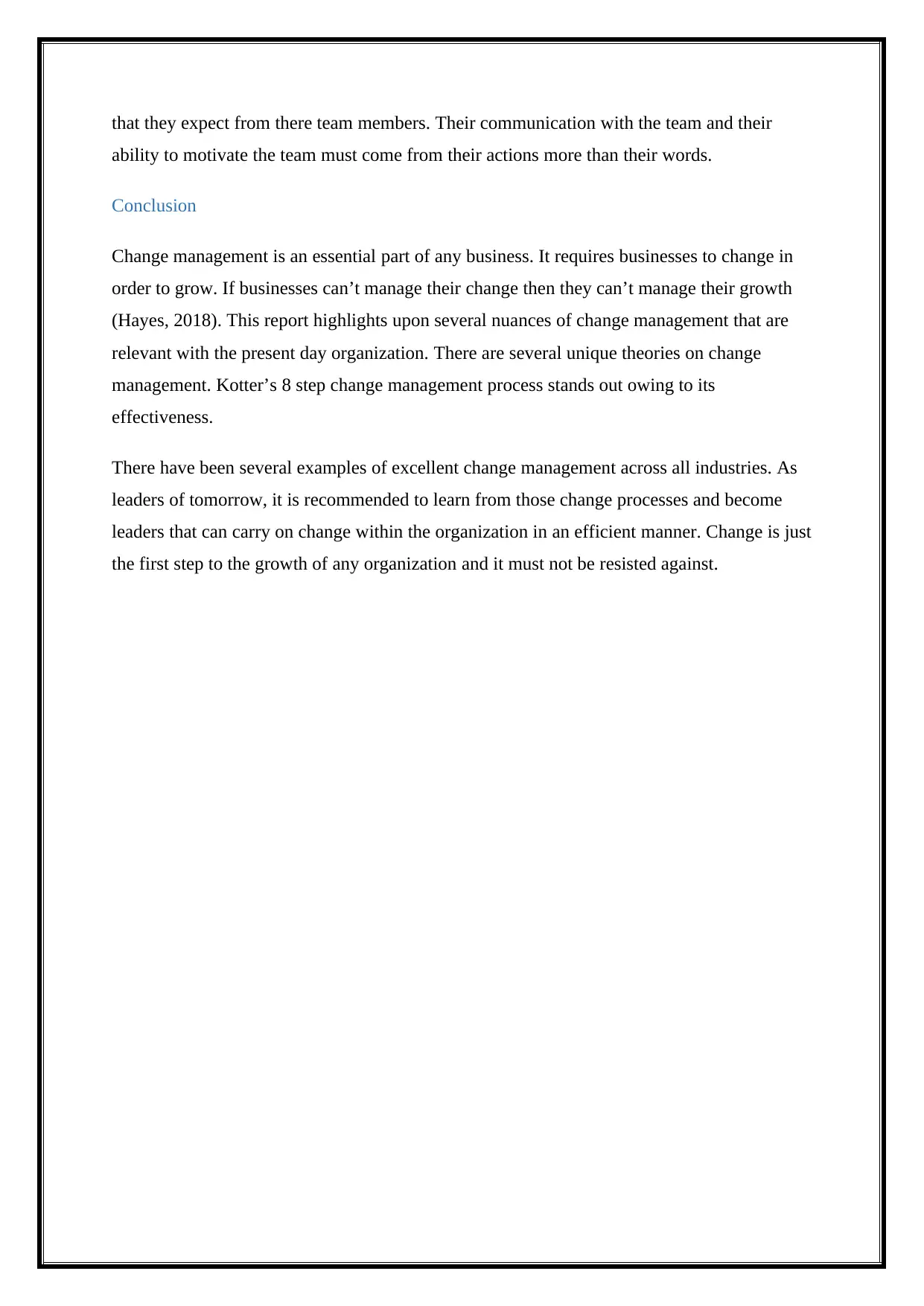
that they expect from there team members. Their communication with the team and their
ability to motivate the team must come from their actions more than their words.
Conclusion
Change management is an essential part of any business. It requires businesses to change in
order to grow. If businesses can’t manage their change then they can’t manage their growth
(Hayes, 2018). This report highlights upon several nuances of change management that are
relevant with the present day organization. There are several unique theories on change
management. Kotter’s 8 step change management process stands out owing to its
effectiveness.
There have been several examples of excellent change management across all industries. As
leaders of tomorrow, it is recommended to learn from those change processes and become
leaders that can carry on change within the organization in an efficient manner. Change is just
the first step to the growth of any organization and it must not be resisted against.
ability to motivate the team must come from their actions more than their words.
Conclusion
Change management is an essential part of any business. It requires businesses to change in
order to grow. If businesses can’t manage their change then they can’t manage their growth
(Hayes, 2018). This report highlights upon several nuances of change management that are
relevant with the present day organization. There are several unique theories on change
management. Kotter’s 8 step change management process stands out owing to its
effectiveness.
There have been several examples of excellent change management across all industries. As
leaders of tomorrow, it is recommended to learn from those change processes and become
leaders that can carry on change within the organization in an efficient manner. Change is just
the first step to the growth of any organization and it must not be resisted against.
⊘ This is a preview!⊘
Do you want full access?
Subscribe today to unlock all pages.

Trusted by 1+ million students worldwide
1 out of 14
Related Documents
Your All-in-One AI-Powered Toolkit for Academic Success.
+13062052269
info@desklib.com
Available 24*7 on WhatsApp / Email
![[object Object]](/_next/static/media/star-bottom.7253800d.svg)
Unlock your academic potential
Copyright © 2020–2025 A2Z Services. All Rights Reserved. Developed and managed by ZUCOL.




